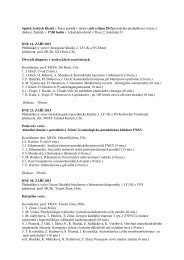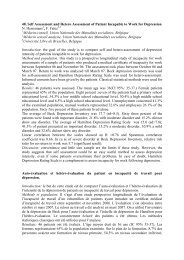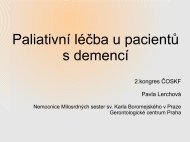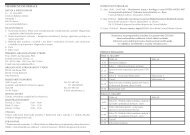ABSTRACTS â ORAL PRESENTATIONS - AMCA, spol. s r.o.
ABSTRACTS â ORAL PRESENTATIONS - AMCA, spol. s r.o.
ABSTRACTS â ORAL PRESENTATIONS - AMCA, spol. s r.o.
You also want an ePaper? Increase the reach of your titles
YUMPU automatically turns print PDFs into web optimized ePapers that Google loves.
NEP developmental stages were distinguished on the basis of different values of CD105,<br />
CD117, FSC parameters. Pro-erythroblasts were characterized by the expression of<br />
CD71 + , CD105 + , CD117 + and the highest value of FSC; basophilic erythroblasts by the<br />
expression of CD71 + , CD105 + and decreased FSC; polychromatophilic erythroblasts by<br />
the expression of CD71 + and medium FSC; orthochromatophilic erythroblasts by the<br />
CD71 + and the lowest FSC value. NEP developmental stages expressed CD36, CD38 and<br />
CD45 in various intensity and did not express CD34 and HLA-DR.<br />
Knowledge of the expression profiles of normal NEPs, we used for the analysis of<br />
erythroid population in two cases of AML-M6 subtype erythroleukaemia, which we were<br />
analysed in the years 2008-2013.<br />
In first case of erythroleukaemia we identified the presence of myeloblasts (9% from<br />
BM nucleated cells) with aberrant phenotype (CD7 + , CD22 + ) and NEPs (75%). NEPs<br />
comprised of amplified cells of different developmental stages (7% pro-erythroblasts,<br />
5.4% basophilic erythroblasts, 21.5% polychromatophilic erythroblasts, and 38.8%<br />
orthochromatophilic erythroblasts). All stages displayed aberrantly reduced CD71<br />
expression (decreased intensity) and orthochromatophilic erythroblast expressed<br />
slightly decreased intensity of CD36 (90%).<br />
Patient underwent treatment, achieved complete remission and subsequently<br />
underwent allogeneic stem cell transplantation. Nine months after diagnosis, this<br />
patient relapsed, showing the presence of myeloblasts (21%) and NEPs (49%) in the<br />
BM. Pro-erythroblasts and basophilic erythroblasts possessed normal phenotype,<br />
polychromatophilic erythroblasts displayed aberrantly reduced CD71 expression (50%),<br />
and orthochromatophilic erythroblasts lost CD71 expression (1%) and showed reduced<br />
CD235a expression (30%).<br />
In second case of erythroleukaemia we identified in diagnosis the presence of myeloblasts<br />
(6%) with aberrant phenotype (CD38 dim , CD15 dim , CD13 - ) and NEPs (82%) in the BM.<br />
Neoplastic NEPs comprised of mass of cells with aberrant phenotype (CD36 neg-bright ,<br />
CD71 medium , CD235a + , CD105 dim , HLA-DR dim , CD38 dim a CD117 - ), aberrantly increased SSC<br />
characteristic and without the possibility to distinguish different NEPs developmental<br />
stages. Detection of minimal residual disease by flow cytometry on day 33 and 64 was<br />
based on identification of residual NEPs with aberrant phenotype. However, during<br />
follow-up we identified NEPs (2%), in which it was possible to identify all 4 developmental<br />
stages with normal phenotype.<br />
Conclusions: AML-M6 is very rare type of AML that accounts for less than 5% of adult<br />
AML cases. MDS is more frequent clonal malignant disorder, in which also NEPs could<br />
possess phenotypic abnormalities, such as asynchronous expression of CD71 versus<br />
CD235a (Malcovati et al., 2005), altered distribution of nucleated red blood progenitors<br />
and increased numbers of CD36 -/low NEPs (Matarraz et al., 2010). In clinical laboratories,<br />
the phenotype of neoplastic NEPs in AML-M6 or MDS is evaluated as a one whole that<br />
causes losing information about aberrant phenotypes on different NEP developmental<br />
stages - important information for leukaemia follow-up. Our proposed NEP gating scheme<br />
allows for the exact assessment of phenotype of different NEP developmental stages in<br />
BM. Evaluation of CD71, CD235a, CD117, CD105, CD36, CD45 antigen expression is also<br />
recommended in standardized Euroflow panels for AML/MDS.<br />
62 Analytical Cytometry VII








